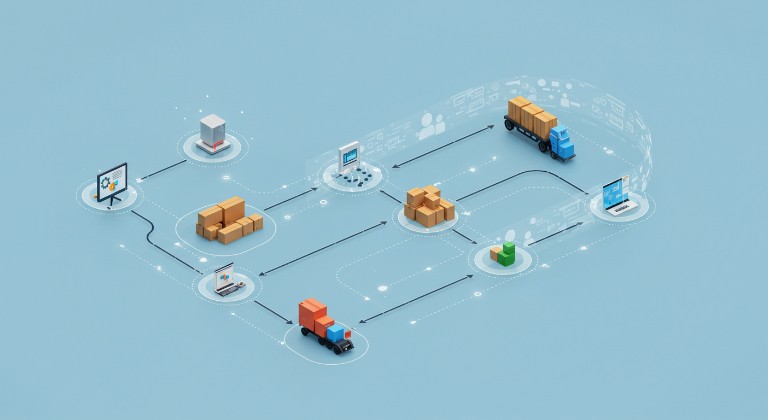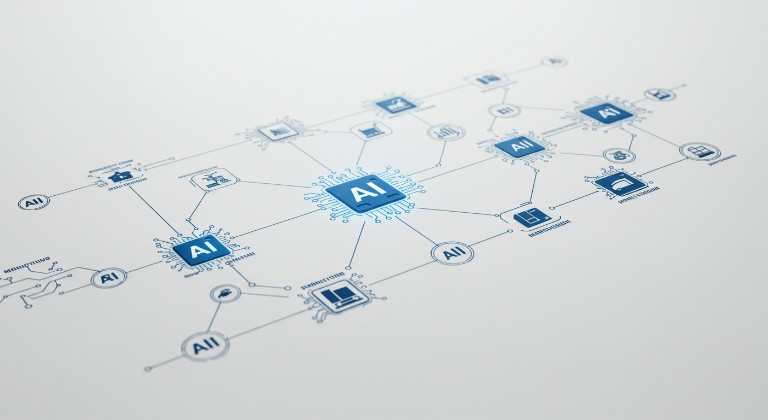Supply chain management (SCM) has always been a cornerstone of successful businesses. But as global supply chains grow more complex, the challenges of managing them efficiently have skyrocketed. Enter artificial intelligence (AI) — a game-changer that’s revolutionizing how businesses operate. If you’ve ever wondered how AI can help optimize your supply chain, you’re in the right place. Let’s dive into how this cutting-edge technology is reshaping the world of logistics and inventory management.

Table of Contents
What is AI in Supply Chain Management, and How Does It Work?
AI in supply chain management involves using intelligent algorithms and machine learning (ML) to enhance efficiency and decision-making processes. Think of it as a super-smart assistant that analyzes massive amounts of data to identify patterns, predict outcomes, and recommend actions.
Here’s how it works:
- Data Collection: IoT devices, sensors, and cloud-based systems gather real-time data from various supply chain touchpoints.
- Data Processing: Machine learning algorithms analyze this data, extracting valuable insights.
- Actionable Insights: AI tools provide recommendations for demand forecasting, inventory optimization, and logistics planning.
For instance, IBM Watson Supply Chain provides predictive insights and actionable recommendations, helping businesses tackle issues before they escalate. Insert image of IBM Watson dashboard here.
AI systems integrate seamlessly with existing software to offer dynamic solutions, enabling real-time adjustments in supply chain processes. This adaptability is crucial in today’s volatile markets, where quick decision-making can make or break a company’s bottom line.
The Benefits of AI in Supply Chain Management
Implementing AI in your supply chain can lead to transformative benefits:
Improved Demand Forecasting
Accurate demand forecasting prevents overproduction or stockouts. AI-powered tools analyze historical sales data, market trends, and even social media chatter to predict consumer demand. This is crucial in seasonal industries like retail or agriculture.
AI doesn’t just predict; it adapts. For instance, AI-driven tools can adjust forecasts in real time based on sudden changes like weather events or viral trends, ensuring businesses stay ahead of the curve.
Enhanced Inventory Optimization
AI-driven inventory management systems like Blue Yonder help businesses maintain optimal stock levels by:
- Reducing excess inventory
- Preventing stockouts
- Automating replenishment systems
Inventory optimization with AI minimizes waste and aligns inventory with demand, saving businesses money while improving customer satisfaction.
Streamlined Logistics and Transportation
AI optimizes delivery routes, reduces fuel consumption, and minimizes delays. FourKites, for example, specializes in real-time shipment tracking and predictive analytics to streamline logistics.
With logistics route optimization, companies can cut delivery times significantly. This not only improves customer experience but also reduces environmental impact by lowering fuel usage.
Risk Management and Resilience
AI tools like Resilinc provide real-time supplier risk monitoring, enabling businesses to pivot quickly in the face of disruptions.
By identifying potential disruptions—be it natural disasters or geopolitical issues—AI enhances resilience, ensuring that supply chains remain operational under stress.
Real-World Applications of AI in Supply Chains

Let’s look at how leading companies leverage AI to stay ahead:
- Amazon: Uses AI to optimize warehouse operations, predict customer demand, and automate delivery routes.
- Walmart: Employs predictive analytics to enhance inventory management, ensuring shelves are always stocked.
- Maersk: Implements AI-powered risk management systems to navigate global supply chain disruptions.
Insert a table comparing the AI tools used by Amazon, Walmart, and Maersk.
AI applications are not limited to these giants. Small and medium enterprises (SMEs) are increasingly adopting AI solutions tailored to their unique needs, leveling the playing field in competitive markets.
Predictive Analytics in Supply Chain Management
Predictive analytics takes AI to the next level, using data to foresee future outcomes. For example, ThroughPut.ai offers actionable recommendations for logistics planning and demand sensing, enabling businesses to stay proactive.
How It Works:
- Data Analysis: Identifies trends and potential risks.
- Scenario Simulation: Models various “what-if” situations.
- Decision Support: Provides recommendations based on likely outcomes.
Predictive analytics empowers businesses to prepare for multiple scenarios, ensuring they’re never caught off guard by unexpected events.
Challenges of Adopting AI in Supply Chains
Adopting AI isn’t all sunshine and rainbows. Here are some hurdles businesses face:
High Initial Investment
Implementing AI solutions can be costly, particularly for small and medium-sized businesses. However, cloud-based platforms and subscription models are making AI more accessible.
Data Silos
Fragmented data sources make it difficult to integrate AI across the supply chain. Companies must prioritize data unification to unlock AI’s full potential.
Resistance to Change
Employees may resist adopting new technologies due to fear of job displacement. Investing in training and emphasizing AI’s role as a supportive tool can ease this transition.
Top AI Tools for Supply Chain Optimization
Here’s a roundup of the best AI tools to consider:
| Tool | Key Feature | Best For |
|---|---|---|
| IBM Watson Supply Chain | Predictive insights and real-time visibility | Inventory and supplier management |
| Blue Yonder | Demand planning and inventory optimization | Retail and manufacturing |
| Resilinc | Supplier risk monitoring | Risk management |
| FourKites | Real-time shipment tracking | Logistics and transportation |
| AWS Supply Chain | End-to-end visibility and sustainability tracking | Comprehensive SCM |
Emerging tools like ThroughPut.ai and Elementum are also gaining traction for their innovative features, offering businesses more choices tailored to specific needs.
FAQs About AI in Supply Chain Management
1. How Can AI Improve Demand Forecasting?
AI analyzes diverse data sources, including sales trends and weather patterns, to accurately predict consumer demand. This reduces inefficiencies and improves customer satisfaction.
2. What Role Does AI Play in Logistics?
AI optimizes delivery routes, reduces transit times, and ensures timely deliveries through tools like Google Cloud SCM Solutions.
3. Can AI Assist in Risk Management?
Absolutely. Tools like Everstream Analytics identify potential disruptions, from weather issues to geopolitical risks, ensuring businesses remain prepared.
4. Which Industries Benefit Most from AI in Supply Chains?
Industries like retail, manufacturing, and healthcare see significant advantages from AI-driven supply chain solutions.
Conclusion
AI is not just a buzzword; it’s a practical solution for modern supply chain challenges. From improving demand forecasting to optimizing logistics and enhancing resilience, AI is transforming how businesses operate. Ready to take your supply chain to the next level? Start exploring tools like IBM Watson or Blue Yonder today.




